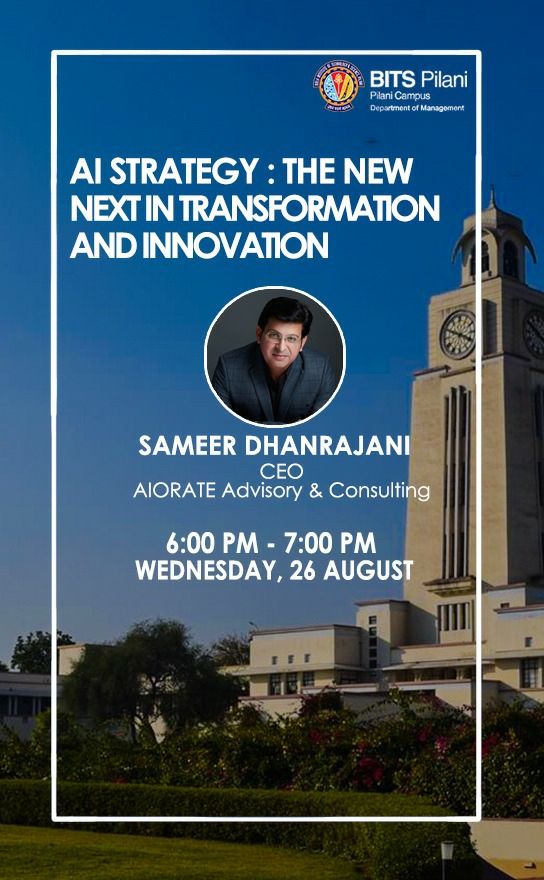
Webinar on AI Strategy at BITS Pilani
Add Your Heading Text Here

Continuing with the webinar series for the batch of 2021 & 2022 along with our noteworthy alumni, BITS Pilani called-in AIQRATE for a session is on ‘AI Strategy : The new next in Transformation and Innovation’ by Mr Sameer Dhanrajani , on 26th August 2020.
Related Posts
AIQRATIONS

Webinar on AI & Analytics – Chitkara Business School
Add Your Heading Text Here

Related Posts
AIQRATIONS

Emergence of AI Powered Enterprise: Strategic considerations for Leaders
Add Your Heading Text Here

The excitement around artificial intelligence is palpable. It seems that not a day goes by without one of the giants in the industry coming out with a breakthrough application of this technology, or a new nuance is added to the overall body of knowledge. Horizontal and industry-specific use cases of AI abound and there is always something exciting around the corner every single day.
However, with the keen interest from global leaders of multinational corporations, the conversation is shifting towards having a strategic agenda for AI in the enterprise. Business heads are less interested in topical experiments and minuscule productivity gains made in the short term. They are more keen to understand the impact of AI in their areas of work from a long-term standpoint. Perhaps the most important question that they want to see answered is – what will my new AI-enabled enterprise look like? The question is as strategic as it is pertinent. For business leaders, the most important issues are – improving shareholder returns and ensuring a productive workforce – as part of running a sustainable, future-ready business. Artificial intelligence may be the breakout technology of our time, but business leaders are more occupied with trying to understand just how this technology can usher in a new era of their business, how it is expected to upend existing business value chains, unlock new revenue streams, and deliver improved efficiencies in cost outlays. In this article, let us try to answer these questions.
AI is Disrupting Existing Value Chains
Ever since Michael Porter first expounded on the concept in his best-selling book, Competitive Advantage: Creating and Sustaining Superior Performance, the concept of the value chain has gained great currency in the minds of business leaders globally. The idea behind the value chain was to map out the inter linkages between the primary activities that work together to conceptualize and bring a product / service to market (R&D, manufacturing, supply chain, marketing, etc.), as well as the role played by support activities performed by other internal functions (finance, HR, IT etc.). Strategy leaders globally leverage the concept of value chains to improve business planning, identify new possibilities for improving business efficiency and exploit potential areas for new growth.
Now with AI entering the fray, we might see new vistas in the existing value chains of multinational corporations. For instance:
- Manufacturing is becoming heavily augmented by artificial intelligence and robotics. We are seeing these technologies getting a stronger foothold across processes requiring increasing sophistication. Business leaders need to now seriously consider workforce planning for a labor force that consists both human and artificial workers at their manufacturing units. Due attention should also be paid in ensuring that both coexist in a symbiotic and complementary manner.
- Logistics and Delivery are two other areas where we are seeing a steady growth in the use of artificial intelligence. Demand planning and fulfilment through AI has already reached a high level of sophistication at most retailers. Now Amazon – which handles some of the largest and most complex logistics networks in the world – is in advanced stages of bringing in unmanned aerial vehicles (drones) for deliveries through their Amazon Prime Air program. Business leaders expect outcomes to range from increased customer satisfaction (through faster deliveries) and reduction in costs for the delivery process.
- Marketing and Sales are constantly on the forefront for some of the most exciting inventions in AI. One of the most recent and evolved applications of AI is Reactful. A tool developed for eCommerce properties, Reactful helps drive better customer conversions by analyzing the clickstream and digital footprints of people who are on web properties and persuades them into making a purchase. Business leaders need to explore new ideas such as this that can help drive meaningful engagement and top line growth through these new AI-powered tools.
AI is Enabling New Revenue Streams
The second way business leaders are thinking strategically around AI is for its potential to unlock new sources of revenue. Earlier, functions such as internal IT were seen as a cost center. In today’s world, due to the cost and competitive pressure, areas of the business which were traditionally considered to be cost centers are require to reinvent themselves into revenue and profit centers. The expectation from AI is no different. There is a need to justify the investments made in this technology – and find a way for it to unlock new streams of revenue in traditional organizations. Here are two key ways in which business leaders can monetize AI:
- Indirect Monetization is one of the forms of leveraging AI to unlock new revenue streams. It involves embedding AI into traditional business processes with a focus on driving increased revenue. We hear of multiple companies from Amazon to Google that use AI-powered recommendation engines to drive incremental revenue through intelligent recommendations and smarter bundling. The action item for business leaders is to engage stakeholders across the enterprise to identify areas where AI can be deeply ingrained within tech properties to drive incremental revenue.
- Direct Monetization involves directly adding AI as a feature to existing offerings. Examples abound in this area – from Salesforce bringing in Einstein into their platform as an AI-centric service to cloud infrastructure providers such as Amazon and Microsoft adding AI capabilities into their cloud offerings. Business leaders should brainstorm about how AI augments their core value proposition and how it can be added into their existing product stack.
AI is Bringing Improved Efficiencies
The third critical intervention for a new AI-enabled enterprise is bringing to the fore a more cost-effective business. Numerous topical and early-stage experiments with AI have brought interesting success for reducing the total cost of doing business. Now is the time to create a strategic roadmap for these efficiency-led interventions and quantitatively measure their impact to business. Some food for thought for business leaders include:
- Supply Chain Optimization is an area that is ripe for AI-led disruption. With increasing varieties of products and categories and new virtual retailers arriving on the scene, there is a need for companies to reduce their outlay on the network that procures and delivers goods to consumers. One example of AI augmenting the supply chain function comes from Evertracker – a Hamburg-based startup. By leveraging IOT sensors and AI, they help their customers identify weaknesses such as delays and possible shortages early, basing their analysis on internal and external data. Business leaders should scout for solutions such as these that rely on data to identify possible tweaks in the supply chain network that can unlock savings for their enterprises.
- Human Resources is another area where AI-centric solutions can be extremely valuable to drive down the turnaround time for talent acquisition. One such solution is developed by Recualizer – which reduces the need for HR staff to scan through each job application individually. With this tool, talent acquisition teams need to first determine the framework conditions for a job on offer, while leaving the creation of assessment tasks to the artificial intelligence system. The system then communicates the evaluation results and recommends the most suitable candidates for further interview rounds. Business leaders should identify such game-changing solutions that can make their recruitment much more streamlined – especially if they receive a high number of applications.
- The Customer Experience arena also throws up very exciting AI use cases. We have now gone well beyond just bots answering frequently asked questions. Today, AI-enabled systems can also provide personalized guidance to customers that can help organizations level-up on their customer experience, while maintaining a lower cost of delivering that experience. Booking.com is a case in point. Their chatbot helps customers identify interesting activities and events that they can avail of at their travel destinations. Business leaders should explore such applications that provide the double advantage of improving customer experience, while maintaining strong bottom-line performance.
The possibilities for the new AI-enabled enterprises are as exciting as they are varied. The ideas shared are by no means exhaustive, but hopefully seed in interesting ideas for powering improved business performance. Strategy leaders and business heads need to consider how their AI-led businesses can help disrupt their existing value chains for the better, and unlock new ideas for improving bottom-line and top-line performance. This will usher in a new era of the enterprise, enabled by AI.
(AIQRATE, A bespoke global AI advisory and consulting firm. A first in its genre, AIQRATE provides strategic AI advisory services and consulting offerings across multiple business segments to enable clients on their AI powered transformation & innovation journey and accentuate their decision making and business performance.
AIQRATE works closely with Boards, CXOs and Senior leaders advising them on navigating their Analytics to AI journey with the art of possible or making them jump start to AI progression with AI@scale approach followed by consulting them on embedding AI as core to business strategy within business functions and augmenting the decision-making process with AI. We have proven bespoke AI advisory services to enable CXO’s and Senior Leaders to curate & design building blocks of AI strategy, embed AI@scale interventions and create AI powered organizations. AIQRATE’s path breaking 50+ AI consulting frameworks, assessments, primers, toolkits and playbooks enable Indian & global enterprises, GCCs, Startups, SMBs, VC/PE firms, and Academic Institutions enhance business performance and accelerate decision making.
Visit www.aiqrate.ai to experience our AI advisory services & consulting offerings )
Related Posts
AIQRATIONS

Personal Data Sharing & Protection: Strategic relevance from India’s context
Add Your Heading Text Here

India’s Investments in the digital financial infrastructure—known as “India Stack”—have sped up the large-scale digitization of people’s financial lives. As more and more people begin to conduct transactions online, questions have emerged about how to provide millions of customers adequate data protection and privacy while allowing their data to flow throughout the financial system. Data-sharing among financial services providers (FSPs) can enable providers to more efficiently offer a wider range of financial products better tailored to the needs of customers, including low-income customers.
However, it is important to ensure customers understand and consent to how their data are being used. India’s solution to this challenge is account aggregators (AAs). The Reserve Bank of India (RBI) created AAs in 2018 to simplify the consent process for customers. In most open banking regimes, financial information providers (FIPs) and financial information users (FIUs) directly exchange data. This direct model of data exchange—such as between a bank and a credit bureau—offers customers limited control and visibility into what data are being shared and to what end. AAs have been designed to sit between FIPs and FIUs to facilitate data exchange more transparently. Despite their name, AAs are barred from seeing, storing, analyzing, or using customer data. As trusted, impartial intermediaries, they simply manage consent and serve as the pipes through which data flow among FSPs. When a customer gives consent to a provider via the AA, the AA fetches the relevant information from the customer’s financial accounts and sends it via secure channels to the requesting institution. implementation of its policies for consensual data-sharing, including the establishment and operation of AAs. It provides a set of guiding design principles, outlines the technical format of data requests, and specifies the parameters governing the terms of use of requested data. It also specifies how to log consent and data flows.
There are several operational and coordination challenges across these three types of entities: FIPs, FIUs, and AAs. There are also questions around the data-sharing business model of AAs. Since AAs are additional players, they generate costs that must be offset by efficiency gains in the system to mitigate overall cost increases to customers. It remains an open question whether AAs will advance financial inclusion, how they will navigate issues around digital literacy and smartphone access, how the limits of a consent-based model of data protection and privacy play out, what capacity issues will be encountered among regulators and providers, and whether a competitive market of AAs will emerge given that regulations and interoperability arrangements largely define the business.
Account Aggregators (AA’s):
ACCOUNT AGGREGATORS (AAs) is one of the new categories of non banking financial companies (NBFCs) to figure into India Stack—India’s interconnected set of public and nonprofit infrastructure that supports financial services. India Stack has scaled considerably since its creation in 2009, marked by rapid digitization and parallel growth in mobile networks, reliable data connectivity, falling data costs, and continuously increasing smartphone use. Consequently, the creation, storage, use, and analyses of personal data have become increasingly relevant. Following an “open banking “approach, the Reserve Bank of India (RBI) licensed seven AAs in 2018 to address emerging questions around how data can be most effectively leveraged to benefit individuals while ensuring appropriate data protection and privacy, with consent being a key element in this. RBI created AAs to address the challenges posed by the proliferation of data by enabling data-sharing among financial institutions with customer consent. The intent is to provide a method through which customers can consent (or not) to a financial services provider accessing their personal data held by other entities. Providers are interested in these data, in part, because information shared by customers, such as bank statements, will allow providers to better understand customer risk profiles. The hypothesis is that consent-based data-sharing will help poorer customers qualify for a wider range of financial products—and receive financial products better tailored to their needs.
Data Sharing Model : The new perspective:
Paper based data collection is inconvenient , time consuming and costly for customers and providers. Where models for digital-sharing exist, they typically involve transferring data through intermediaries that are not always secure or through specialized agencies that offer little protection for customers. India’s consent-based data-sharing model provides a digital framework that enables individuals to give and withdraw consent on how and how much of their personal data are shared via secure and standardized channels. India’s guiding principles for sharing data with user consent—not only in the financial sector— are outlined in the National Data Sharing and Accessibility Policy (2012) and the Policy for Open Application Programming Interfaces for the Government of India. The Information Technology Act (2000) requires any entity that shares sensitive personal data to obtain consent from the user before the information is shared. The forthcoming Personal Data Protection Bill makes it illegal for institutions to share personal data without consent.
India’s Ministry of Electronics and Information Technology (MeitY) has issued an Electronic Consent Framework to define a comprehensive mechanism to implement policies for consensual data-sharing. It provides a set of guiding design principles, outlines the technical format of the data request, and specifies the parameters governing the terms of use of the data requested. It also specifies how to log both consent and data flows. This “consent artifact” was adopted by RBI, SEBI, IRDAI, and PFRDA. Components of the consent artifact structure include :
- Identifier : Specifies entities involved in the transaction: who is requesting the data, who is granting permission, who is providing the data, and who is recording consent.
- Data : Describes the type of data being accessed and the permissions for use of the data. Three types of permissions are available: view (read only), store, and query (request for specific data). The artifact structure also specifies the data that are being shared, date range for which they are being requested, duration of storage by the consumer, and frequency of access.
- Purpose : Describes end use, for example, to compute a loan offer.
- Log : Contains logs of who asked for consent, whether it was granted or not, and data flows.
- Digital signature : Identifies the digital signature and digital ID user certificate used by the provider to verify the digital signature. This allows providers to share information in encrypted form
The Approach :
THE AA consent based data sharing model mediates the flow of data between producers and users of data, ensuring that sharing data is subject to granular customer consent. AAs manage only the consent and data flow for the benefit of the consumer, mitigating the risk of an FIU pressuring consumers to consent to access to their data in exchange for a product or service. However, AAs, as entities that sit in the middle of this ecosystem, come with additional costs that will affect the viability of the business model and the cost of servicing consumers. FIUs most likely will urge consumers to go directly to an AA to receive fast, efficient, and low-cost services. However, AAs ultimately must market their services directly to the consumer. While AA services are not an easy sell, the rising levels of awareness among Indian consumers that their data are being sold without their consent or knowledge may give rise to the initial wave of adopters. While the AA model is promising, it remains to be seen how and when it will have a direct impact on the financial lives of consumers.
Differences between Personal Data Protection & GDPR ?
There are some major differences between the two.
First, the bill gives India’s central government the power to exempt any government agency from the bill’s requirements. This exemption can be given on grounds related to national security, national sovereignty, and public order.
While the GDPR offers EU member states similar escape clauses, they are tightly regulated by other EU directives. Without these safeguards, India’s bill potentially gives India’s central government the power to access individual data over and above existing Indian laws such as the Information Technology Act of 2000, which dealt with cyber crime and e-commerce.
Second, unlike the GDPR, India’s bill allows the government to order firms to share any of the non personal data they collect with the government. The bill says this is to improve the delivery of government services. But it does not explain how this data will be used, whether it will be shared with other private businesses, or whether any compensation will be paid for the use of this data.
Third, the GDPR does not require businesses to keep EU data within the EU. They can transfer it overseas, so long as they meet conditions such as standard contractual clauses on data protection, codes of conduct, or certification systems that are approved before the transfer.
The Indian bill allows the transfer of some personal data, but sensitive personal data can only be transferred outside India if it meets requirements that are similar to those of the GDPR. What’s more, this data can only be sent outside India to be processed; it cannot be stored outside India. This will create technical issues in delineating between categories of data that have to meet this requirement, and add to businesses’ compliance costs.

